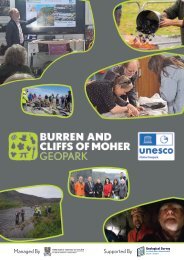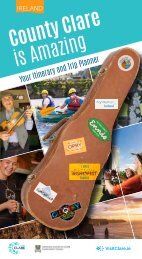Burren and Cliffs of Moher UNESCO Global Geopark - Geology
A collection of articles about the geology in the Burren and Cliffs of Moher UNESCO Global Geopark written by Dr Eamon Doyle - Geopark Geologist
A collection of articles about the geology in the Burren and Cliffs of Moher UNESCO Global Geopark written by Dr Eamon Doyle - Geopark Geologist
Create successful ePaper yourself
Turn your PDF publications into a flip-book with our unique Google optimized e-Paper software.
Fossil sponges: shining a light on some<br />
<strong>of</strong> our most overlooked fossils.<br />
Sponges are not the most glamorous things in the world,<br />
at best they might be delicious cakes or comforting bath<br />
scrubs, while in our kitchens they are man-made plastic<br />
porous blocks we use to help clean the dishes. The original<br />
sponges are living creatures however <strong>and</strong> most <strong>of</strong> us don’t<br />
stop to think about them, so here is a little background to<br />
the most overlooked creatures in the fossil record.<br />
These fascinating creatures are alive <strong>and</strong> well in all our<br />
seas today (a few live in fresh water), although many<br />
were in danger <strong>of</strong> extinction due to overfishing before<br />
the arrival <strong>of</strong> synthetic replacements. Sponges are simple<br />
multi-cellular organisms that don’t have a nervous or<br />
circulatory system or even a digestive tract. No limbs<br />
or eyes or teeth either. They have a porous jelly-like<br />
body that is supported by a network <strong>of</strong> microscopic<br />
skeletal elements known as ‘spicules’ that can be straight,<br />
cross or star-shaped. They draw water in through their<br />
porous bodies where microrganisms are filtered out <strong>and</strong><br />
processed by the cells for food.<br />
It has been over 500 million years (half a billion years!)<br />
since the first sponges appeared <strong>and</strong> they are thought to<br />
be one <strong>of</strong> the earliest animal lineages to have evolved.<br />
Sponges can be found in all the geological ages from then<br />
to the present day <strong>and</strong> they have evolved a wide variety<br />
<strong>of</strong> lifestyles. Most are attached to rocks or the seafloor,<br />
but some can drift in currents; most filter microrganisms<br />
from the water, but some are predatory <strong>and</strong> capture prey<br />
with long sticky threads or hooked spikes; they can vary<br />
in sze from 1mm to several metres <strong>and</strong> can live in shallow<br />
water or down to the deepest ocean floor many kilometers<br />
below the sea surface.<br />
Sponges have an extraordinary ability to regenerate<br />
themselves from fragments. This is important in assuring<br />
their survival; even if a small part <strong>of</strong> a sponge survives a<br />
predator it can grow into a new animal.<br />
So, do we find fossil sponges in the rocks <strong>of</strong> the <strong>Burren</strong><br />
<strong>and</strong> <strong>Cliffs</strong> <strong>of</strong> <strong>Moher</strong> <strong>UNESCO</strong> <strong>Global</strong> <strong>Geopark</strong>? Yes,<br />
we do, although they are not easy to spot because it is<br />
usually only the tiny (2mm) spicules that get preserved as<br />
fossils. This is why they are so overlooked. However, you<br />
might more easily find some evidence <strong>of</strong> the sponges that<br />
currently live along our coast, as some have the ability to<br />
dissolve limestone <strong>and</strong> make tiny complex burrows in the<br />
rock.<br />
Sponges are an important part <strong>of</strong> our modern ocean<br />
ecosystem <strong>and</strong> they were an equally important part <strong>of</strong><br />
our geological ecosystems in the distant past. Finding<br />
fossil sponges adds one more piece <strong>of</strong> information to our<br />
underst<strong>and</strong>ing <strong>of</strong> our ancient biodiversity.<br />
Figure caption: A tiny spicule <strong>of</strong> a fossil sponge (left) recently collected in the <strong>Burren</strong> <strong>and</strong> <strong>Cliffs</strong> <strong>of</strong> <strong>Moher</strong> <strong>UNESCO</strong> <strong>Global</strong> <strong>Geopark</strong> <strong>and</strong> (right)<br />
modern sponge borings in a <strong>Burren</strong> limestone pebble.


















